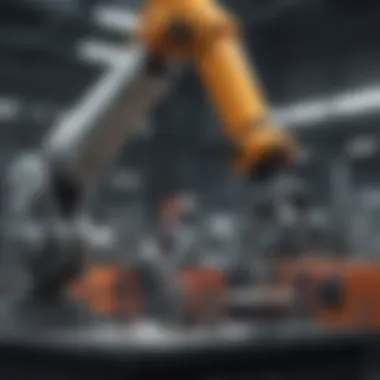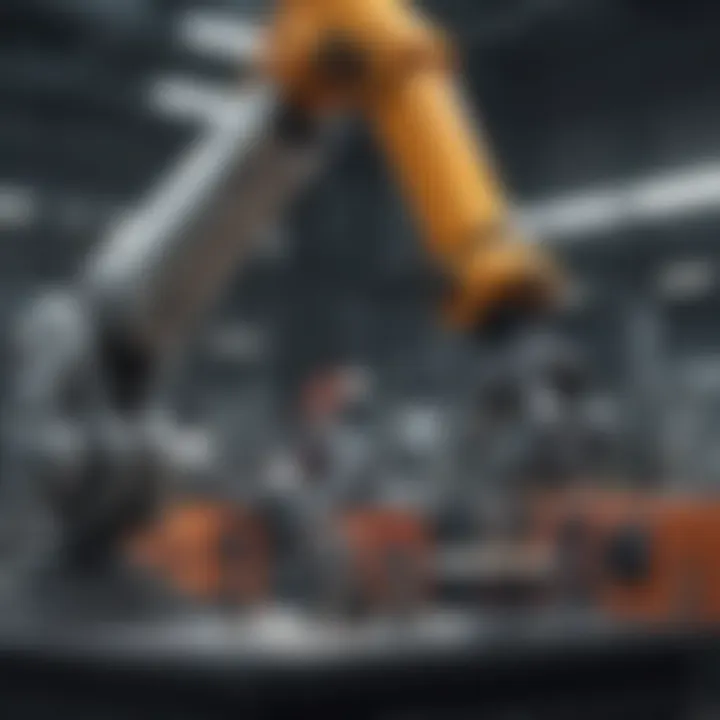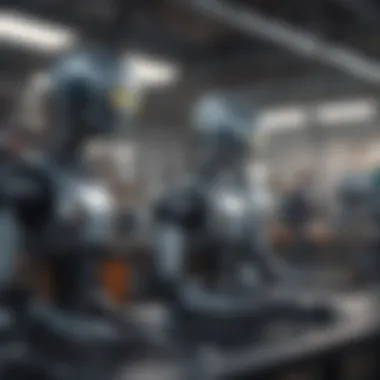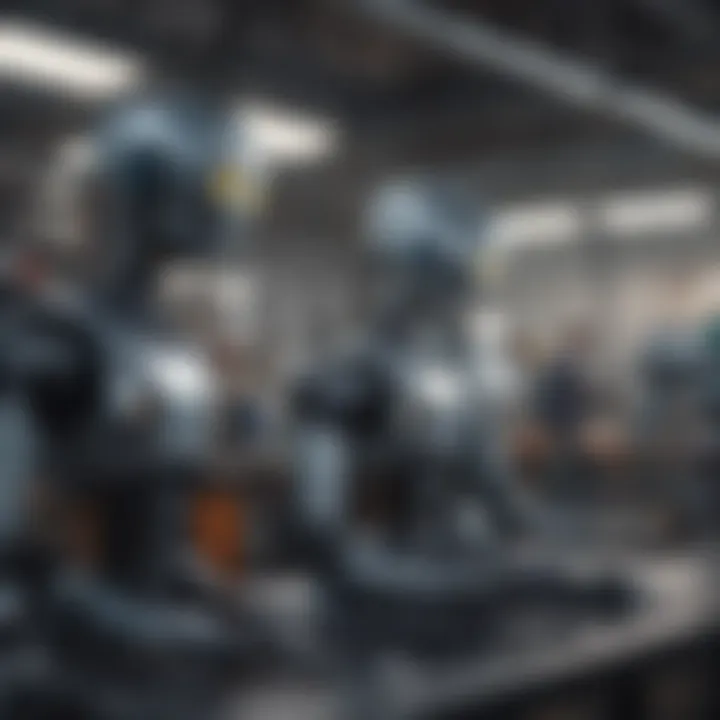Exploring the Diverse Functions of Robots Today


Intro
In today's world, robots have become an integral part of various industries, extending their influence way beyond what most people can fathom. These machines, once confined to the realms of science fiction, now play crucial roles in sectors ranging from healthcare to agriculture and beyond. This article endeavors to shed light on the multifaceted nature of robots and how they are reshaping our societal landscape.
The rapid advancements in robotic technology have not only sparked industrial revolutions but have also introduced significant changes in how humans interact with machines. As these technologies evolve, a deeper understanding of their functions is essential. The discussion aims to engage students, researchers, educators, and professionals alike, offering comprehensive insights into the operational mechanisms, benefits, and ethical considerations associated with robots in contemporary society.
Understanding the nuances of robotics requires more than just recognizing their physical presence; it calls for an exploration into their underlying technologies and the profound impact they have on improving efficiency and effectiveness in work processes.
Preamble to Robotics
In the rapid pace of today’s world, the significance of Robotics cannot be overstated. These machines, capable of performing a myriad of tasks, are increasingly interwoven into the fabric of our daily lives. From the factories where robots manufacture goods to healthcare settings where they assist in surgeries, the role of robots is vast and multilayered. Understanding the fundamentals of robotics is not merely an academic exercise; it has real-world implications affecting industries, economies, and even individual lives.
The exploration of robotics begins with defining what a robot truly is. Not all machines qualify under the term "robot," as they often possess characteristics that enable them to act autonomously or semi-autonomously. This capability distinguishes them from conventional machinery. The importance of robots lies not just in their functions but also in how they change our perceptions of work, efficiency, and human capability. Moreover, as we carve further into the realm of robotic technology, this understanding leads to deeper contemplation about the implications of relying on machines.
Defining Robots
When pinpointing the definition of robots, a straightforward approach can be misleading. Traditionally, a robot is considered a programmable machine that can perform specific tasks autonomously. These machines can sense their environment, perform actions based on that data, and learn from the outcomes of those actions. They can take various forms, from industrial arms to humanoid shapes, and even autonomous drones.
Robots can be categorized broadly:
- Industrial Robots: Employed mainly in manufacturing and production lines, where their precision and speed contribute significantly to efficiency.
- Service Robots: Aimed at assisting humans in everyday tasks or within specific service sectors like healthcare and hospitality.
- Medical Robots: Specialized units designed for surgical procedures and patient care.
- Agricultural Robots: Innovating farming practices by automating processes such as planting and harvesting.
The hybrid nature of robots, merging elements of mechanical engineering, electrical engineering, computer science, and even cognitive psychology, makes defining them a complex task.
Historical Development
The journey of robotics is both fascinating and layered with milestones that reflect human ingenuity and the evolution of technology. The concept of automata dates back to ancient civilizations, where simple machines mimicked human actions. For instance, the Greek engineer Hero of Alexandria designed steam-powered devices in the first century. These early inventions, though rudimentary, laid the groundwork for future innovations.
Fast forward to the 20th century, and you see the industrial revolution giving rise to the first modern robots. In 1956, George Devol showcased Unimate, the first industrial robot, which was later used in General Motors’ assembly lines. This initiated the practical application of robotics in industrial environments, dramatically changing manufacturing processes.
The following decades saw exponential growth in robotics research and application, spurred by advances in computing, artificial intelligence, and materials science. Today, robots extend beyond factories and workplaces into households and industries such as healthcare and agriculture, reflecting a substantial shift in perception regarding the capabilities and roles of robots in society.
As contemporary discussions around robotics unfold, it is critical to appreciate this historical context. Understanding where we come from provides insights into not only how we develop and utilize robots but also the ethical considerations we must navigate as these machines become ever more prominent in our lives.
"The rise of robotics urges us to reconsider our perceptions of work, efficiency, and ethics in a modern context."
As we continue to explore the roles of robots and their multifaceted applications, the significance of these definitions and historical advancements creates a solid foundation for the discourse that follows.
Types of Robots and Their Functions
In discussing the multifaceted roles of robots today, understanding the types of robots and their functions proves crucial. Various categories of robots exist, each designed to tackle distinct tasks relevant to their environments. Their importance lies in not just enhancing efficiency, but also in shaping how we live, work, and interact with technology. The functions of these robots manifest through advancements in fields ranging from manufacturing and healthcare to everyday assistance and agricultural practices.
Industrial Robots
Assembly line automation
Assembly line automation stands as a cornerstone in the industrial robot landscape. It’s all about streamlining the production process, enhancing speed and accuracy. The critical characteristic of this automation is its ability to operate continuously without fatigue, unlike human workers. This makes it a popular choice among manufacturers looking for consistency.
A unique feature of assembly line automation involves the use of robotics to perform repetitive tasks. By doing so, it minimizes human error significantly, as machines can maintain precision with little deviation. The advantages are clear: decreased production time and increased output. However, a formidable disadvantage remains – the risk of job displacement in unskilled positions.
Welding and fabrication
Welding and fabrication robots contribute significantly to producing metal structures effectively. Their key trait is the ability to perform high-quality welds faster than any human could, which is particularly beneficial in automotive and construction industries. Their efficiency helps in meeting tight deadlines and upholding product quality standards.
These robots usually have automated systems for measuring and ensuring the correct parameters for welding. The distinct advantage here lies in achieving uniformity across all products, leading to less rework and waste. However, concerns about the high initial cost and maintenance required could deter smaller businesses from investing in these technologies.
Packaging
Packaging robots play a vital role in finalizing products and preparing them for distribution. Their key characteristic is the speed at which they can pack goods, often outperforming a human workforce. This makes packaging robots a favored choice for companies wanting to speed up the end of their production line.
The unique feature of packaging robots is their ability to adapt to various product types and sizes, enhancing flexibility in manufacturing. When discussing advantages, the reduction in labor costs and the efficiency gained in packaging processes come to mind. On the downside, though, the reliance on these machines may result in challenges when needing to adjust to sudden changes in packaging requirements or product designs.
Service Robots
Domestic tasks
Domestic tasks covered by service robots illustrate how technology is become an integral part of everyday life. These robots primarily focus on chores such as vacuuming, lawn mowing, or even window cleaning. The significant benefit they offer is freeing up time for individuals to focus on other activities by handling mundane tasks.
A key characteristic of domestic task robots is their convenience and ease of use. Many are equipped with advanced mapping technology, enabling them to navigate efficiently while ensuring thorough cleaning is achieved. While they are advantageous for time management, their limitations emerge when confronting complex home layouts or unanticipated obstructions.
Customer service applications
Customer service applications exemplify the adaptability of robots in various environments such as retail and hospitality. Here, the primary goal is to cater to customer inquiries and enhance user experience while relieving staff pressure during peak hours. The key feature of these robots is their ability to provide consistent responses, ensuring customers receive reliable information.
Unique qualities of customer service robots lie in their integration with AI to deliver tailored experiences. However, a drawback includes their inability to fully emote as a human would, which can sometimes lead to disengagement among customers craving a personal touch.
Hospitality and entertainment


In the hospitality and entertainment sectors, robots have started to emerge as hosts, concierges, or even performers. Their importance in these areas is profound, as they help aid staff and enhance overall guest experience. The key characteristic of these robots is their ability to attract attention and provide novel experiences in establishments like hotels or theme parks.
The unique feature of hospitality robots is their multifaceted capabilities, often programmed to engage guests in fun and informative ways. While they bring a fresh angle to service, the challenge remains that some traditionalists in the industry may see their presence as a threat to human jobs, sparking ongoing debates about the nature of service work.
Medical Robots
Surgical assistance
Surgical assistance robots represent a significant innovation in the medical field. These robots enhance precision during delicate procedures, a characteristic that is non-negotiable in surgeries. Helping surgeons perform intricate tasks with accuracy and stability accentuates their critical role in today's medical practises.
Specifically, the advent of robotic-assisted surgeries allows for smaller incisions, which can lead to reduced recovery times for patients. However, a notable downside is the continuous need for trained personnel to oversee these robots, which requires ongoing education and resource allocation.
Rehabilitation
Rehabilitation robots encompass a vital aspect of patient recovery following injuries or surgeries. By assisting patients with their physical therapy routines, these robots provide crucial guidance and support. Their importance lies in facilitating a structured recovery process and improving patient outcomes.
The key characteristic of rehabilitation robots is their adaptability to individual patient needs, which can vary widely. These technologies often allow for gradual progression in therapy intensity, promoting motivation and engagement. Still, the potential drawback rests in the cost of advanced rehabilitation systems, which might not be accessible to all health facilities.
Telemedicine applications
Incorporating robots into telemedicine applications shapes a new paradigm in health care delivery. Enabling remote consultations and surgical procedures through robotic systems can extend medical services into underserved areas. The key upside is improving patient access to specialist care without the need for travel.
A distinguishing aspect of telemedicine robots is their ability to integrate seamlessly with communication platforms, providing real-time support. On the contrary, limitations arise with the technology itself, over issues like connectivity and the need for robust data security measures.
Agricultural Robots
Cultivation and planting
Cultivation and planting robots showcase how agriculture is evolving through technology. Their essential function involves preparation of fields and sowing seeds efficiently. The significance of these robots is highlighted in their capacity to manage larger plots of land while maintaining high levels of accuracy.
The key characteristic of such robots lies in their ability to adapt to different types of crops and soil conditions. With their precision, they can optimize planting density, which is beneficial for maximizing yields. However, farmers may face challenges with initial investments and maintaining such sophisticated systems.
Harvesting automation
Harvest harvesting automation robots emerge as a critical tool during peak production seasons. They allow farmers to pick crops swiftly, ensuring timely harvest without excessive manual labor. Their importance in this context is driven by their efficiency and ability to reduce waste.
What sets harvesting robots apart is their precision in determining the ripeness of fruit or veggies. This helps to ensure only the best quality produce is selected. However, some disadvantages exist, such as navigating varied terrains and losses when crops are not easily accessible.
Precision farming
Precision farming robots incorporate several technologies to enhance agricultural efficiency. By utilizing data analytics and sensors, they provide real-time insights into soil conditions and crop health. Their significance is paramount in enabling farmers to make informed decisions about resource allocation.
The critical feature of precision farming robots is their ability to collect large volumes of data and act upon it, optimizing operations on the field. Although advantageous, reliance on technology could lead to reduced hands-on experience for new farmers who might find themselves overly dependent on these robots.
The Mechanics of Robotic Functionality
The inner workings of robotic systems are crucial to understand how they interact with the world. The functionality of robots relies heavily on a combination of advanced technologies that incorporate various sensors, artificial intelligence algorithms, and control systems. Each element plays a pivotal role, enabling robots to perform tasks with precision and efficiency. This section delves into the mechanics that underpin robotic functionality, focusing on the essential parts that make robots not just tools, but intelligent assistants.
Sensors and Feedback Systems
Types of sensors
Sensors form the backbone of robotic perception, feeding information about the environment back to the robot's processing unit. There are various types of sensors used in robotics, including but not limited to infrared sensors, ultrasonic sensors, and cameras. Each type is charactrized by its unique method of data gathering. For example, ultrasonic sensors are often used for distance measurement due to their reliable accuracy in detecting obstacles in the path of a robot. This makes them a popular choice, especially in navigation systems.
A distinct advantage of sensors is their ability to gather real-time data, which can significantly impact the performance and responsiveness of robotic systems. However, they also come with challenges, like susceptibility to interference from environmental factors, which could affect their accuracy. Thus, engineers must carefully select and configure sensors for specific applications.
The role of feedback in robotics
Feedback systems help in refining the robot's actions based on sensory input. This ongoing dialogue between sensors and the robot's control algorithms means the robot can make adjustments in real-time. For instance, if a robot is programmed to pick up an object and fails to do so, feedback can prompt it to change its grip or position accordingly.
The key characteristic of feedback is its ability to create a responsive environment, allowing robots to adapt to dynamic situations. Feedback mechanisms enhance precision but can become complex in highly variable environments. This complexity can lead to increased processing requirements, posing limitations for less sophisticated systems.
Artificial Intelligence in Robotics
Machine learning applications
Machine learning represents a revolutionary approach in how robots learn and adapt. By analyzing vast amounts of data, robots can improve their performance over time without human intervention. This self-improving ability allows them to tackle tasks ranging from simple pattern recognition to complex decision-making processes. It is an advantageous addition to robotics because it enables continuous operational refinement.
However, implementing machine learning can be resource-intensive and requires significant computational power, which might not be feasible for all robotic systems. Moreover, the quality of the data used for training directly impacts the effectiveness of the machine learning models. Poor quality or biased data can lead to undesirable outcomes.
Decision-making frameworks
Decision-making frameworks are essential for enabling robots to operate independently in a variety of scenarios. These frameworks equip robots with algorithms that evaluate options based on sensory data, goals, and prior experiences. A key characteristic of these frameworks is flexibility; they can be designed to handle both structured tasks and more nuanced, unstructured problems.
For example, a robot in a warehouse might use decision-making frameworks to optimize inventory retrieval by assessing which items are most efficiently picked. While these frameworks advance robotic autonomy, they also increase the systems' complexity, requiring careful implementation to ensure reliability in dynamic settings and to avoid potential errors in judgment.
Control Systems


Types of robotic control systems
Robotic control systems dictate how a robot behaves and reacts to its environment. They can be centralized, where a single controller directs all operations, or decentralized, where multiple controllers manage various functions. The flexibility in types allows for a tailored approach based on the robot's mission.
Centralized systems are often easier to manage but can become a bottleneck if the processing tasks exceed the controller’s capacity. Conversely, decentralized systems can distribute processing load across various units, facilitating real-time decisions but at the cost of higher coordination overhead. This balance is essential for optimizing robotic performance.
Programming strategies
Effective programming strategies are paramount for designing functional robots. These strategies encompass anything from high-level programming languages to low-level machine code, often depending on the required precision and flexibility of the robotic task.
A key characteristic of robust programming strategies is modularity, which allows for components to be developed and tested independently. This makes troubleshooting simpler and adjustments more straightforward. However, ensuring compatibility and system integrity during integration can prove challenging. The focus on programming strategies needs to marry efficiency with the advanced needs of modern robotics, ensuring robots can perform with accuracy and reliability.
The Impact of Robots on Industries
The integration of robots into various industries marks a seismic shift in operational paradigms. In today’s fast-paced world, businesses are increasingly reliant on automation to drive efficiency and remain competitive. Understanding the consequences of this integration not only illuminates the immediate benefits like cost savings and productivity gains but also sheds light on broader implications such as labor market shifts and ethical considerations.
Efficiency and Productivity Gains
Automation in production
Automation in production has revolutionized the way goods are manufactured. With robots handling repetitive tasks, companies experience substantial increases in output. This efficiency is rooted in a few key traits. First off, robots can operate without the fatigue that stifles human workers, allowing for round-the-clock production.
Moreover, by employing robotics, errors caused by human oversight are drastically reduced. For instance, consider a car manufacturer like Tesla—its assembly lines utilize robots for welding and painting, ensuring high precision. Though the initial setup can take time, the long-term benefits of reduced errors and increased production capacity make automation a worthwhile investment. Companies that have not leveraged these systems find it harder to keep up, underscoring why automation in production is popular among forward-thinking enterprises.
Optimized workflows
Optimizing workflows with robotic systems enhances organizational efficiency in a variety of ways. This typically involves rethinking processes to integrate robotic technology seamlessly. A significant feature of optimized workflows is their adaptability; they can be adjusted based on the specific demands of a task.
Unique to this approach is the ability of robotics to gather real-time data, which aids in continuous process enhancement. For example, in warehouses, robots can identify bottlenecks and communicate with other machines, leading to smoother operations. The downside? Once the system is in place, there can be a considerable learning curve for workers adjusting to new processes. However, the benefits of reducing lead times and increasing throughput make the effort often worthwhile.
Cost Implications
Initial investments
When discussing cost implications, initial investments in robotic systems certainly deserve attention. Setting up robotic infrastructure can require a substantial financial outlay. Factories may need to invest not only in the robots themselves but also in reconfiguring their layouts and training personnel.
However, despite these initial hurdles, the key characteristic of this investment is its potential for rapid returns. Robots often enhance productivity quickly, with many companies reporting ROI within a few years of deployment. The unique feature of initial investments in robotics is the long-term vision required; businesses that commit understand that with time, the automation will streamline processes that save money in the long run.
Long-term savings and ROI
Long-term savings is another crux of the conversation around cost implications. Once robots are integrated and operational hassles are minimized, firms can significantly cut labor costs associated with human workers over time. In many cases, these savings extend beyond the salaries of newly displaced workers.
Crucially, companies also save on training, errors, and operational downtime. For example, a factory might save thousands on defective products thanks to robotic precision. However, it's essential to stress that anticipation of these savings requires rigorous planning and careful, sustained implementation of automated systems, as they are not instantaneous. Firms interested in understanding ROI need to calculate not just the upfront costs but also account for these long-term advantages as part of their strategy.
Labor Market Transformations
Job displacement concerns
Job displacement is a pressing issue tied to the rise of robotics. A key element of this concern is the transitional anxiety experienced by workers whose roles may either change significantly or disappear altogether. In industries that heavily utilize automation, many classic job titles have waned.
While robots can undoubtedly perform tasks faster and often more efficiently, the key characteristic of this disruption raises important questions. Is society ready to handle the impact on livelihoods? A unique feature of this displacement conversation is that it fosters discussions around retraining and upskilling. Workers may feel threatened, but there are moves towards programs that help them transition into new roles, often in more complex jobs that require human oversight.
New employment opportunities
Despite concerns over job displacement, robotics also pave the way for new employment opportunities. As companies integrate robots, there arises a demand for skilled workers who can maintain, operate, and enhance these systems. The character of the workforce is shifting; rather than fearing automation, many see the potential benefits of a higher-skilled labor market.
A notable feature of these new roles is their diversity, spanning fields from robotics engineering to data analysis. They often offer improved compensation compared to previous positions. However, there’s still a challenge: ongoing education and training are crucial to ensuring the workforce is equipped with the necessary skills. Investing in human capital will be a decisive factor in ensuring that the economies of the future remain robust and adaptive to automated progress.
It’s essential to approach the robotics conversation with both optimism and caution, recognizing the transformative power of these machines across diverse industries while ensuring the workforce is not left behind.
Challenges and Limitations of Robotic Systems
The exploration of robotic systems is incomplete without discussing the challenges and limitations that accompany their integration into society. Recognizing these hurdles is crucial not only for improving technology but also for understanding its implications on human life and work.
Technical Limitations
Complex tasks
Complex tasks present a unique avenue of discussion within robotic capabilities. These tasks often involve a confluence of intricate decision-making processes that robots, despite advancements, struggle to navigate. An example of complex tasks includes creating a culinary masterpiece, which requires not only precise measurements but also an understanding of nuances like taste and presentation.
This characteristic poses a significant barrier to the widespread adoption of robots in fields such as gourmet cooking. The technical hurdle comes from the robot’s inability to adapt in real-time to unforeseen circumstances, which is a hallmark of human creativity.
The unique feature of complex tasks is that they often require a blend of technical skill and artistry. While robots can perform rote tasks without breaking a sweat, devising a dish that pleases the palate demands levels of flexibility and intuition that machines have not yet achieved. This limitation underscores the importance of human craftsmanship in contexts where emotional and sensory aspects are key.
Reliability and maintenance issues
Reliability and maintenance issues can’t be overlooked when assessing robotic systems. Robots, like any piece of machinery, require regular upkeep and can break down. A malfunctioning robot in a factory line can halt production, leading to a domino effect that impacts downstream processes. In critical fields such as healthcare, where robots assist in surgeries or patient care, reliability becomes paramount not just for efficiency but for safety.


One key characteristic here is the ongoing need for a qualified technician to conduct regular checks and repairs, which can lead to increased costs and potential downtime. This aspect raises questions about the long-term viability of relying on robots for essential tasks. A unique facet of maintenance is that it requires not just technical fixes but also an understanding of how different robots may behave in varying environments.
The advantages of addressing reliability are clear: it can enhance trust in robotic systems, ensuring they are viewed as reliable partners rather than mere tools. However, the disadvantage remains that integrating these necessary maintenance protocols can complicate operations, leading to frustration among users and operators.
Ethical Considerations
Autonomy in decision-making
The challenge of autonomy in decision-making stands as a critical ethical element in the robotics discourse. As robots gain the ability to make decisions based on data and programming, the question arises: who is accountable for their actions? Autonomous vehicles, for instance, are designed to make split-second decisions during emergencies. If a tragic accident occurs, where does the blame fall?
The key characteristic of autonomy here is its dual-edge nature; it can enhance efficiency and decision-making speed but also complicate accountability. This intricate balance is why it's a thrilling yet daunting choice for discussion in this article.
A unique feature of such autonomy is its potential to surpass human reaction times in certain scenarios. However, it can also lead to ethical quandaries and a lack of transparency regarding decision-making processes. Thus, while the idea of autonomous robots can lead to increased operational efficiency in various tasks, it invites scrutiny and debate regarding ethical implications and consequences.
Privacy concerns
Privacy stands as another towering challenge in the robotic landscape. As robots increasingly infiltrate spaces from private homes to public areas, the potential for invasion of privacy raises significant concerns. Robots that collect data for optimization can inadvertently become invasive, gathering sensitive information from individuals without explicit consent.
One key characteristic of privacy concerns is the potential loss of personal autonomy; as data collection grows ubiquitous, individuals may feel as though their actions are constantly monitored. This is particularly poignant in applications like surveillance drones or retail analytics robots, where the line between helpful service and unwitting observation can blur.
The unique feature here is that while data can provide insights, it also raises issues related to trust and security. The advantages of precise data gathering can lead to better service, but the disadvantages—especially concerning privacy violation—cannot be ignored. Balancing utility with the right to privacy remains a critical ongoing dialogue in the realm of robotics.
In summary, while robotics stand at the forefront of innovation, the challenges related to technical limitations and ethical considerations are equally significant. Understanding these challenges not only helps in shaping better technology but also prepares us for the societal implications thereof.
Future Perspectives in Robotics
Robotics is no longer just a vision of the future; it is an ongoing evolution that reshapes how we interact with technology. The future of robotics is like a set of new puzzle pieces falling into place, offering a glimpse into how these machines will integrate more deeply into various facets of life. As advancements continue, understanding these changes becomes imperative.
Evolving Technologies
Advancements in AI and Machine Learning
Artificial Intelligence (AI) combined with machine learning brings a wave of transformations. These technologies enable robots to analyze data and learn from it, enhancing their functionality over time. For instance, cars equipped with AI can navigate roads by learning traffic patterns and new routes. This adaptability is a significant characteristic making AI a popular choice for robotic systems.
One unique feature of AI-powered robots is their ability to improve operational efficiency. For businesses, it translates to reduced costs and better resource management. However, this progress doesn’t come without concerns; there’s a risk of over-reliance on technology, which may lead to vulnerabilities.
Integration with IoT
The Internet of Things, or IoT, connects devices, allowing them to communicate and share data seamlessly. Its integration into robotics takes automation to another level. Robots interconnected with IoT can gather real-time data and utilize it for immediate decision-making. This significant attribute enhances productivity in various settings, from home automation to industrial applications.
However, with such integration come particular challenges. Privacy becomes a hot topic, especially when personal data is at stake. The unique feature of IoT in robotics raises the bar for smart home technologies, but care must be taken to ensure security. While convenience is a beneficiial outcome, constant vigilance for potential cyber threats is a necessary trade-off.
Potential Applications
Exploration of New Environments
As robots continue to evolve, their capacity to explore uncharted territories will ignite numerous possibilities. For instance, robots equipped with specialized sensors can travel to harsh environments like deep oceans or distant planets, where human presence is limited. This ability to investigate places unapproachable by humans is a pivotal aspect of their role.
The standout capability here is the data collection these exploratory robots can achieve. In environmental monitoring, they offer insights into climate change by gathering crucial data from remote regions. However, navigating unknown terrains does carry risks like equipment failure, which could lead to data loss or operational hindrance.
Robots in Everyday Life
From vacuum cleaners to robotic lawn mowers, robots are carving out a significant niche in daily living. These machines bring convenience and efficiency to household chores, freeing people to pursue activities they enjoy more. The integration of robots into daily life is increasingly becoming a norm, thanks to their user-friendly design and operational ease.
However, the unique feature of these everyday robots is their capacity for personalization. For example, models like iRobot Roomba can learn the layout of a home to clean more effectively. On the flip side, there’s ongoing debate about the potential over-dependence on robots for mundane tasks, raising questions about skill degradation over time.
"The integration of robotics within daily life has profound implications on how routines are structured. We must consider both the benefits and the potential downfalls."
In summary, the future of robotics appears promising, teetering between groundbreaking advancements and critical considerations. As technologies evolve, robots will likely secure a more substantial role in society, presenting new challenges and opportunities in equal measure.
Culmination
As we reflect on the multifaceted roles of robots within contemporary society, it becomes clear that the integration of these machines into various sectors is not simply a trend, but a significant evolution in how we operate and interact with the world around us. Understanding this evolution is crucial for several reasons.
First, robots have shown an extraordinary capacity to enhance efficiency and productivity. In sectors like manufacturing and healthcare, automation not only speeds up processes but also increases precision, leading to better outcomes. For instance, in medical robotics, surgical robots are transforming procedures, allowing for minimally invasive operations which can reduce patient recovery time. This ripple effect presents a clear advantage that demands attention from all stakeholders.
Additionally, the article highlights the ethical considerations surrounding robotics. With autonomy in decision-making and data privacy now at the forefront, professionals must grapple with the implications of these technologies. As robots take on more responsibilities, understanding ethical guidelines becomes vital in ensuring that their deployment does not compromise human values or safety.
Furthermore, the continuous advancement of technologies such as artificial intelligence and machine learning will open new doors for robots, while also posing challenges. A proactive approach in education and policy-making regarding robotics will help shape a future where humans and machines coexist harmoniously.
Summary of Key Points
- Robots enhance efficiency and productivity across multiple sectors.
- Ethical considerations are crucial as robots take on significant roles in decision-making.
- Continuous technological advancements will bring forth new opportunities and challenges.
- Understanding robotics prepares stakeholders for responsible deployment and integration.
Final Thoughts on Robotics
Robots are definitely not just futuristic concepts anymore; they're part of our present reality. As we stand on the cusp of further developments, it's essential for students, researchers, and industry professionals alike to stay informed and engaged. Keeping our ears to the ground and our minds open can help us harness the potential of robotics.
Moreover, as skepticism around robots becomes part of the broader conversation, addressing concerns surrounding jobs, ethics, and safety must take center stage. Society's ability to find a balance between technological advancement and human-centric values is what will ultimately define the coexistence of man and machine.
In the end, whether we find ourselves working alongside robotic coworkers or relying on them for support in our daily lives, the objective should remain clear: to create a future in which innovation enhances the quality of life.
"Technology is best when it brings people together.”
By staying informed and proactive, we can ensure that the evolution of robotics serves the betterment of all.







